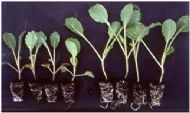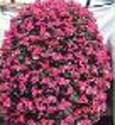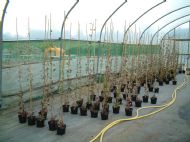For best results right from the start, Broadleaf P4 should be mixed evenly throughout the planting medium (soil/compost/sand etc) and fully charged with water. If it is unlikely that you will get enough rain over the next few days to accomplish this, it is best to irrigate to field capacity and then irrigate again one or two hours later, to ensure the granules have absorbed as much water as possible.
We have provided a wide range of detailed application guidelines below, which can be accesed via the shortcut menu. These are for the most common applications, but there are many other situations and crops for which P4 will be effective. As always, if you cannot easily find what you are looking for, please feel free to contact us and we can give you advice and help relevant to your specific situation.
The guidelines for rates of application are set out below- please click a link to be taken to the appropriate section.
(N.B. 1gm/litre is pro-rata equivalent to 1Kg/m³)
- Propagating
- Pot and Container Plants, Window Boxes, Hanging Baskets
- Soil Planting (Crop and Garden)
- Tree and Shrub Planting
- Interior Landscaping
- Grassed Playing Surfaces
- Cane, Bush and Soft Fruit
- Arid and Semi-Arid Conditions
- Conversions
Propagating

- Seeds and Cuttings.
Striking improvements in germination rate and root growth are achieved when P4 is blended at 1 gram per litre of propagating medium. - Plugs/Modules.
Mix 1 gram of P4 per litre of compost. This creates a very superior seed environment with a much better balance between water supply and aeration. Plants will also get away better after transplanting.
For very small cells we can supply Broadleaf Propagating Polymer (particle size 0.5 to 1.0 mm), which provides a more uniform mix with very fine compost.
Pot and Container Plants, Window Boxes,Hanging Baskets

Broadleaf P4 improves constancy of moisture supply and aeration, and also reduces leaching. Longer intervals between irrigating, stronger, more uniform growth and earlier market or display readiness are typical benefits.
Application guidelines:
1 gram of P4 per litre of compost.
Full grown container plants or hanging baskets on display, with well developed leaf canopy and greater
demand for water, will benefit from the higher rate of 1.75 gms/litre.
In addition, a 3 cm layer of pre-hydrated gel in the base of the container or basket (under the compost)
will help to further extend watering intervals. NB: it will take 2- 3 weeks for the base layer of gel to
become fully colonised by the roots and thus make available to the roots the extra water supply, so be
sure to account for this when watering during that period.
Soil Planting (Crop and Garden)

Broadleaf P4 makes an immediate and long lasting improvement in structure, available water-holding capacity and porosity of hardworking soils. A single application will go on working for around 5 years.
Application guidelines:
For high-density planting of shrubs, ground cover, bedding etc, apply 100 grams/m² and cultivate into the
top 20 or 30 cms.
For field sowing or planting (e.g. carrots, onions, brassicae, strawberries) P4 can be drilled into the
seed row or precision placed in the soil at each plant station.
For row drilling, 100 gms/m² would cover, e.g. 20 metres run of row at 5 cms scatter width.
For placement at each plant station, 2-5 gms per plant (depending on crop, soil and climatic
conditions), would be suitable treatment rates.
Tree and Shrub Planting

Whether bare-root or container grown stock, trees and shrubs will better survive transplanting and require much less frequent irrigating with Broadleaf P4 at their roots. Greatly reduced transplanting losses and much increased extension growth are major benefits.
Application guidelines:
1 gram of P4 per litre of planting pocket capacity, well dispersed throughout. For shrubs or ground cover
planted to a high density, apply as per recommendations for ‘Soil Planting’.
Note: it is important to calculate the actual capacity of the hole- for example, a 10 litre hole for
a rootball comprising 4 litres, will leave a hole of 6 litres, requiring 6g of P4.
It is also helpful to mix the P4 with soil before backfilling, to ensure the P4 is evenly mixed
throughout.
Interior Landscaping
Container plants in places of work and leisure will require much less watering when Broadleaf P4 is on the job day and night, giving a supply of moisture steadily and reliably as required. These high value plantings will look better and last longer.
Application guidelines:
As for ‘Pot and Container Plants’ at potting up. To apply in situ: work dry P4 granules as deeply as possible into the compost, taking care to minimise root damage. Where container-grown plants are to be set into a larger bed, mix the granules into the surrounding bed.
Grassed Playing Surfaces
Broadleaf P4 improves soil structure as well as water-holding capacity, for stronger, deeper root growth and reduced watering requirement.
ESTABLISHMENT RATE, apply 20 gms/m² and cultivate into the top 5 cms. Sow seeds or lay turf and irrigate to field capacity to fully charge the soil and polymer with water (unless there is adequate rainfall to accomplish this). This rate will assist rapid establishment.
MAINTENANCE RATE, apply 50 gms/m² for fine turf, 100 gms/m² for coarse turf and cultivate into the top 20 or 30 cms. Proceed as for 'Establishment Rate'. This will assist rapid establishment and also reduce irrigation and fertiliser requirements for the longer term.
SAND BASED CONSTRUCTION: As for 'Maintenance Rate', above.
Cane, Bush and Soft Fruit
These can be highly susceptible to drought and subsequent loss of crop size. Broadleaf P4 will maintain the moisture supply much longer, improve soil structure and help you to achieve high-grade results even on marginal-grade soil.
Application guidelines:
100 grams/m² cultivated into the top 20-30 cms applied in the row or individual planting station. For application to established crops cultivate into the soil as close to the plants as possible, taking care to minimise root damage.
Arid and Semi-Arid Conditions
Where hot, dry conditions cause very high rates of evapo-transpiration, P4 application rates should be adjusted according to the salinity of the irrigation water, as indicated below:
| Electrical Conductivity in mS./cm-1 | |||
| 4 | 7 | 16 | |
| Increase foregoing rates by | x2 | x3 | x4 |
Conversions
1 gm/litre is pro-rata equivalent to 1 kg/m³ or 1.7 lbs/yd³.
100gms/m2 is pro-rata equivalent to 1000kgs/ha or 3oz/yd2 or 8cwts/acre